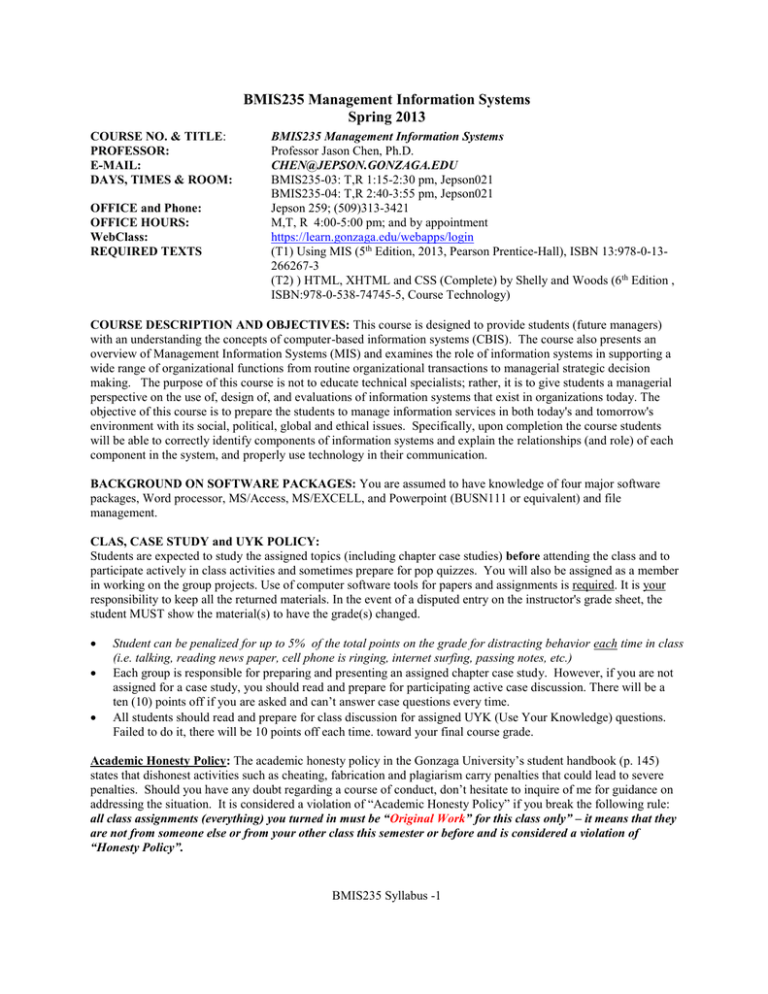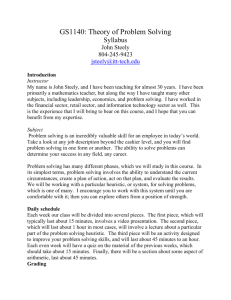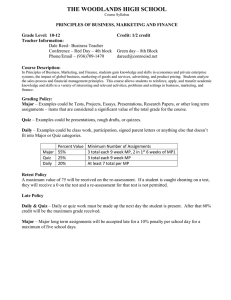
BMIS235 Management Information Systems
Spring 2013
COURSE NO. & TITLE:
PROFESSOR:
E-MAIL:
DAYS, TIMES & ROOM:
OFFICE and Phone:
OFFICE HOURS:
WebClass:
REQUIRED TEXTS
BMIS235 Management Information Systems
Professor Jason Chen, Ph.D.
CHEN@JEPSON.GONZAGA.EDU
BMIS235-03: T,R 1:15-2:30 pm, Jepson021
BMIS235-04: T,R 2:40-3:55 pm, Jepson021
Jepson 259; (509)313-3421
M,T, R 4:00-5:00 pm; and by appointment
https://learn.gonzaga.edu/webapps/login
(T1) Using MIS (5th Edition, 2013, Pearson Prentice-Hall), ISBN 13:978-0-13266267-3
(T2) ) HTML, XHTML and CSS (Complete) by Shelly and Woods (6 th Edition ,
ISBN:978-0-538-74745-5, Course Technology)
COURSE DESCRIPTION AND OBJECTIVES: This course is designed to provide students (future managers)
with an understanding the concepts of computer-based information systems (CBIS). The course also presents an
overview of Management Information Systems (MIS) and examines the role of information systems in supporting a
wide range of organizational functions from routine organizational transactions to managerial strategic decision
making. The purpose of this course is not to educate technical specialists; rather, it is to give students a managerial
perspective on the use of, design of, and evaluations of information systems that exist in organizations today. The
objective of this course is to prepare the students to manage information services in both today's and tomorrow's
environment with its social, political, global and ethical issues. Specifically, upon completion the course students
will be able to correctly identify components of information systems and explain the relationships (and role) of each
component in the system, and properly use technology in their communication.
BACKGROUND ON SOFTWARE PACKAGES: You are assumed to have knowledge of four major software
packages, Word processor, MS/Access, MS/EXCELL, and Powerpoint (BUSN111 or equivalent) and file
management.
CLAS, CASE STUDY and UYK POLICY:
Students are expected to study the assigned topics (including chapter case studies) before attending the class and to
participate actively in class activities and sometimes prepare for pop quizzes. You will also be assigned as a member
in working on the group projects. Use of computer software tools for papers and assignments is required. It is your
responsibility to keep all the returned materials. In the event of a disputed entry on the instructor's grade sheet, the
student MUST show the material(s) to have the grade(s) changed.
Student can be penalized for up to 5% of the total points on the grade for distracting behavior each time in class
(i.e. talking, reading news paper, cell phone is ringing, internet surfing, passing notes, etc.)
Each group is responsible for preparing and presenting an assigned chapter case study. However, if you are not
assigned for a case study, you should read and prepare for participating active case discussion. There will be a
ten (10) points off if you are asked and can’t answer case questions every time.
All students should read and prepare for class discussion for assigned UYK (Use Your Knowledge) questions.
Failed to do it, there will be 10 points off each time. toward your final course grade.
Academic Honesty Policy: The academic honesty policy in the Gonzaga University’s student handbook (p. 145)
states that dishonest activities such as cheating, fabrication and plagiarism carry penalties that could lead to severe
penalties. Should you have any doubt regarding a course of conduct, don’t hesitate to inquire of me for guidance on
addressing the situation. It is considered a violation of “Academic Honesty Policy” if you break the following rule:
all class assignments (everything) you turned in must be “Original Work” for this class only” – it means that they
are not from someone else or from your other class this semester or before and is considered a violation of
“Honesty Policy”.
BMIS235 Syllabus -1
Blackboard, E-MAIL and Web POLICY: It is your responsibility to check class announcements on the Blackboard
and your E-MAIL (the one on the Blackboard) periodically. There might have important messages announced on the
Blackboard and/or sent to you via the E-MAIL so that all of students will keep class information up-to-dated (and
information from your classmates/friends) and step toward the information/Internet age. Furthermore, Your GU
email account will be used for creating your personal Web page.
E-mail Communication – All e-mail communications with me should bear the course and section number (viz:
BMIS235-XX [Web-assignment1]) in the subject line (XX indicates the section number i.e., 03 or 04, of the
class you are in), without which the e-mail is likely to be unread. Furthermore, you should include “Dr. Chen”
and “your full name” at the beginning and end of the content of each email respectively.
QUIZZES: You will take a quiz for each chapter (from the main text) during a designated period. These quizzes
will contain true-false and/or multiple choice questions. Each quiz normally has 11 questions (10 possible points
with 1 point bonus) and you should complete it within the time limit (usually 10 minutes; however, you should be
able to complete it in about 5 minutes if you read/prepare the chapter well) on midnight Sunday. There will be 12
quizzes this semester. Quizzes are available under ‘Tests & Quizzes’ button on the Bb. The rules of taking
tests/quizzes are:
(1) Students are NOT allowed to take this assessment multiple times. Therefore, you should use a computer with
reliable/stable internet connection. To be fair to all students, an zero point will be assigned if you lost Internet
connection.
(2) Students must complete the assessment the first time it is launched
(3) Time limit: 15 minutes for every quiz.
(4) There will be 1 point off for every 15 seconds if you exceed the specified time limit.
ASSIGNMENTS
Assignments such as case studies, EXCEL, Access should be emailed with attachment (Word and Excel files) to the
instructor. Web assignments (HTML etc.) should be created using your GU email account and I will grade/check it
after the due date. Assignments are available under ‘Assignments’ button on the Bb.
EXAMS: There will be two (2) midterm exams will include only that material covered since the previous exam.
This includes material from the textbook, software packages books, and class discussions -- all can appear on the
exams. The type of exam will be left up to the instructor. It may be objective, essay, or a case problem. Your
instructor will specify the format before the exam. No credit will be received if you miss an exam unless you have
permission from the instructor and/or obtain a University-approved absence.
COURSE ATTENDANCE
If you miss a class session without what I consider a legitimate excuse (be sure that you should have my permission
in advance or present a university-approved evidence after the missed class), I reserve the right to lower your final
course grade to the next lower grade (e.g., from A to A- and so on) for each class you missed. The more classes you
missed the more grade levels will be lowered down. You must contact the instructor about every absence.
Furthermore, students should be aware of the University policy regarding absence. According to the university
policy, "[T]he grade given for excessive absence is V, which has the same effect as F and is counted in the
GPA....The fact that a student has met other course requirements (such as papers) is not sufficient to change a
V to a passing grade." (Catalogue, p. 38). The total time of excessive absence in this class is 300 minutes, equivalent
to four absences. In other words, if one student misses four classes for whatever reasons, he/she should expect a V
for his/her final grade.
DREAM Students: If you are in the DREAM (Disability Resources, Education and Access) program, it is your
responsibility to inform me one week in advance and contact DREM office for arranging EVERY test in the DREAM
office.
GRADE POLICY ON SOFTWARE ASSIGNMENTS/LECTURES:
You must complete all computer assignments, or you will receive an F on your final grade. If you violate dishonest
policy on any software assignments, quizzes, exams etc. you will receive an F on the course grade. You are allowed
BMIS235 Syllabus -2
to discuss with other students on the computer assignments, however, you should do your own work and understand
the work you turned in. You may be asked/selected randomly to explain any work your turned in. It is considered as
the violation of dishonest policy, if you fail to explain any work you turned in.
FINAL EXAM SCHEDULE:
BMIS235-03 (1:15 class): Thursday, May 9, 3:30 to 5:30 pm
BMIS235-04 (2:40 class): Tuesday, May 7, 3:30 to 5:30 pm
GRADE DISSTRIBUTION:
Quizzes 12@10
...........................................................................…........ 120
Midterm exams (2 @ 150)
...................................................................... 300
Class performance and participation
….................................................... 30
Collaboration Software Project …………………………………………..
10
Excel Assignments ……………………………………………….……… 10-30
Database assignments ……………………………………………………… 20-40
Web assignments ………………………………………………………… 40-50
Chapter case presentation …………………………………………………
20
Term project ………………………………………………………………… 50
Other projects (if assigned) ………………………………………………….. 20
Final Exam (Comprehensive)
..................................................................... 200
--------------------------------------------------------------------------------------------------------Total
820/870 points
If you receive a zero on any of COMPUTER assignment, your final course grade is F.
(The above grading components may be slightly changed if needed).
GRADE RANGES:
Percentage >=94
Grade
A
>=90
A-
>=87
B+
>=84
B
>=80
B-
>=77
C+
BMIS235 Syllabus -3
>=74
C
>=70
C-
>=65
D+
>=60
D
<60
F
[Week]
Date
[1]
Jan. 15
Jan. 17
[2]
Jan. 22
Jan. 24
[3]
Jan. 29
Jan. 31
[4]
Feb. 5
Feb. 7
[5]
Feb. 12
Feb. 14
[6]
Feb. 19
Feb. 21
[7]
Feb. 26
Feb. 28
BMIS235 – SCHEDULE –(Tentative, 1/8/2013)
Topic and Activities
Quiz/HW/
HW/CASE
UYK Assigned
Due
Course Introduction and
Intro. To MIS
Software Development Life Cycle (SDLC)
If you miss today’s class, you must drop the
class – according to university policy
(T1) 1: MIS and You
UYK#1(2)-p.25
Organizing Groups
(T1) 1: MIS and You (cont.)
Quiz - Ch.1
Case#1 (1,2,3,5,6;
(Due Sunday,
p.27-29)
Jan. 27)
Ethics Guide
(Situations A,B,C
Q:1&2; p.16-17)
Introduction to Computer Facility: MS
1. Web#1
Windows, Jepson labs and Barney Systems
2.Collaboration
(T3-1) File Transfer Protocol
project
Web Assignment#1
(You are required to create a gmail account by
this weekend)
Improving your Personal Web Page
Web#2
Web#1;
Collaboration
Project (via Bb)
(T1) 2: Collaboration Information Systems
UYK#2(a-e)Case #2 (1-5)
p.69 [do this
p.71-73
before the class;
and ask 2.f]
Quiz - Ch.2
(T2) 1: Introduction to HTML, XHTML, and
Web#2 &
CSS
HTML_hw#1
(T1) 3: Strategy and Information Systems
(T1) 3: Strategy and Information Systems
UYK#3(4,5)Case#3(1,2,3,6,7)
(cont.)
p.99-100
p.101-102
Quiz - Ch.3
Study:www.bosu.
com
(T2) 2: Creating and Editing a Web Page Using
HTML_hw#2
Inline Styles
EXAM I
(T1) 4: Hardware and Software
EXCEL assignment#1 (Stanley Cookware)
UYK#4(1)p.135
Quiz - Ch. 4
(T2) 3: Creating Web Pages with Links,
Images, and Embedded Style Sheets
(T2) 3: Creating Web Pages with Links,
Images, and Embedded Style Sheets (cont.)
BMIS235 Syllabus -4
Case#4 (1-5;
p.137-139)
Excel#1
HTML_hw#3 and
enhance your
personal web
page
Chapter
Case Study
ALL
GROUPS
G1
G2
ALL
GROUPS
[8]
Mar. 5
(T1) 5: Database Processing
Mar. 7
(T1) 5: Database Processing (cont.)
[9]
Mar. 11 –
Mar. 15
[10]
Mar. 19
HAPPY SPRING BREAK – NO CLASS
Mar. 21
[11]
Mar. 26
Mar. 28
[12]
April 2
(T1) 6: Data Communication and Cloud
EXCEL assignment#2 (Wilmington Tool)
other topic
(T1) 7: Structured Processes and
Information Systems
UYK#5(1,2,3,4,
5)p.171-172
Quiz – Ch.5
UYK#6(1)p.209
Quiz - Ch.6
UYK#7(4 or 5)p.251
Quiz - Ch.7
Case #5 (1-5;
p.174-175)
Project: Phase I
ALL
GROUPS
Case #6 (1 thru
5) (p.210-212)
G3
Case#7 (1-4;6;
p.254-255)
G4
Exam II
(T2) 4: Creating Tables in a Web Site Using an
External Style Sheet
(T2) 4: Creating Tables in a Web Site Using an
External Style Sheet (cont.)
[12]
April 4
(T1) 8: Social Media Information Systems
[13]
April 9
April 11
(T1) 9: Business Intelligence Systems
W[14]
April 16
(T1) 10: Business Process and Information
Systems Development
UYK#10(2)p.383
Quiz Ch.10
April 18
(T1) 11: Information Systems Management
UYK#11(4)p.409
Quiz Ch.11
[15]
April 23
April 25
Academic Honors Convocation (NO CLASS)
[16]
April 30
Project presentation
(T1) 9: Business Intelligence Systems (cont.)
(T1) 12: Information Security Management
UYK#8(2,4)p.293
Quiz -Ch.8
App. Ex:#1
(Buy vs. Make)
UYK#9(3,5)p.335
Quiz - Ch.9
UYK#12(4)p.449
Quiz Ch.12
BMIS235 Syllabus -5
HTML_hw#4 and
enhance your
personal web
page
Case#8
(1-5; p.294-295)
Project: Phase II
G5
App. Ex.#1 (OLAP)
Case#9
(1,2,4,5; p.336339)
Guide: Dealing
with Uncertainly
(p.378)
Case#10
(1,2a-c,3a-c,4)
(p.384-385)
Case#11(1,2,5,6;
p.410)
G6
Case#12(1-5;
p.450)
Final Bonus
Personal Web
Page
Project:
Completed Report
(All Groups)
ALL
GROUPS
ALL
GROUPS
G7
ALL
GROUPS
May 2
Project presentation
ALL
GROUPS
[17]
FINAL EXAM (Comprehensive)
May 7-10
Note that:
UYK: Using Your Knowledge; Case: Case Study (both are at the end of each chapter)
(T1) Using MIS (5th Edition, Pearson Prentice-Hall)
(T2) New Perspectives on Creating Web Pages with HTMLand XHTML by Patrick Carey
(T3) Tutorials will be handed out in classes.
(T3-0) Online HTML tutorials (http://www.w3schools.com/) and HTML tag reference
(http://www.w3schools.com/tags/default.asp)
(T3-1) Introduction to FTP
(T3-2) Report Generation
Final Personal Web Page (bonus) should include all chapters you learned from the class and two other chapters that
you learn by yourself (Learning to Learn and Learning to Change!)
Information for end of Chapter Case Presentation:
1. For Presentation Group:
a. The file name should be like BMIS235-0X-GY-ChapterZ_Case.ppt (e.g., BMIS235-01-G2-Capter8_Case.ppt
b. A Powerpoint e-file should be emailed with an attachment to me the midnight before the day of your presentation
c. A hardcopy of powerpoint (TWO slides per page) should be turned in to me in the class
2. All other students – see Class, Case Study and UYK policy.
PROJECT PROGRESS REPORT
Phase I: Your group may either make up a business scenario or select an appropriate topic from a reality. Turn in a
written report includes project’s description (scenario) and its objectives (what you try to accomplish and how –
employing Porter’s model ; see more details below) about 2 pages.
Phase II: Extend the content on Phase I and add base model (or implementation) to your existing report. It should be
with at least 4 pages.
FIANL REPORT: see information below, it should be organized well, comprehensive and complete.
Project Outline (How to improve/create competitive advantage using Porter’s Model and Generic Strategies and
with SDLC approach)
1. Project Theme: Decision Making in the Information Age
2. Project Title: (A Specific title that you should provide on the proposal)
A. Introduction: (with your selected topic)
B. Objectives to achieved
C. Main body (detailed description of business applications, OLAP and Web page inclusion and more)
D. Conclusion: suggestions, comparison, and future observations in working with this project.
PROJECT’S FORMAT and CONTENTS
The final project written report should include the following (but not limited to):
1.
Project scenario. (what is the problem domain?)
2.
Project objective. (what goals/Objectives your group try to accomplish and suggest?)
3.
What and how were they accomplished?
a) Employ Porter’s Five-competitive force and value chain models and generic strategies and think critically
that how to improve competitive advantage/business value.
b) Follow a well-defined SDLC (what is SDLC?)
4.
Describe the managerial and organizational (and others) impacts on your project.
5.
Develop a prototype (small working system) using Excel or Access and embedded it in the Web environment.
6.
Conclusion. It should include suggestions, comparison, and future observations in working with this project.
7.
The project should be available on the Internet (available on one of group member’s web site).
BMIS235 Syllabus -6
Policy on the Group Project and Presentation:
All the group members will receive the same grade as I assigned on the FINAL report except that those do not
contribute their efforts on the project based on the survey from the evaluation of the team members. The group leader
or the majority of the group members should report the project progress to the instructor in case that there is (are)
major problem(s) in your group.
Both SOFT (with email attachment) and HARD copies of written report (Word formt), Powepoint and EXCEL
(OLAP) files should be turned in. Include GROUP# and members’ names on the cover page. For example, specify
the following information:
Subject: BMIS235-03-G1 Term Project.
File name: BMIS235-03-G1-Term Project.docx, BMIS235-03-G1-Term Project.pptx, BMIS235-03-G1-Term
Project.xlsx.
Note that BMIS235-03-G1 indicates Section#3 and Group#1.
A hardcopy of the term project (all documents) should be turned at the beginning of the first day of presentation no
matter which group you are. The presentation is formal, dressed up and using POWERPOINT and other presentation
aids. The group leader should assign/distribute responsibility to all members for working and presenting the project.
The grade will be based on the following criteria: (1) presentation, (2) content of the problem domain (using SDLC
methodology), (3) Implementations with software packages (e.g, Web page design, Office Suite etc.), (4) a written
report, (5) time management and dress code (formal presentation).
BMIS235 Syllabus -7





